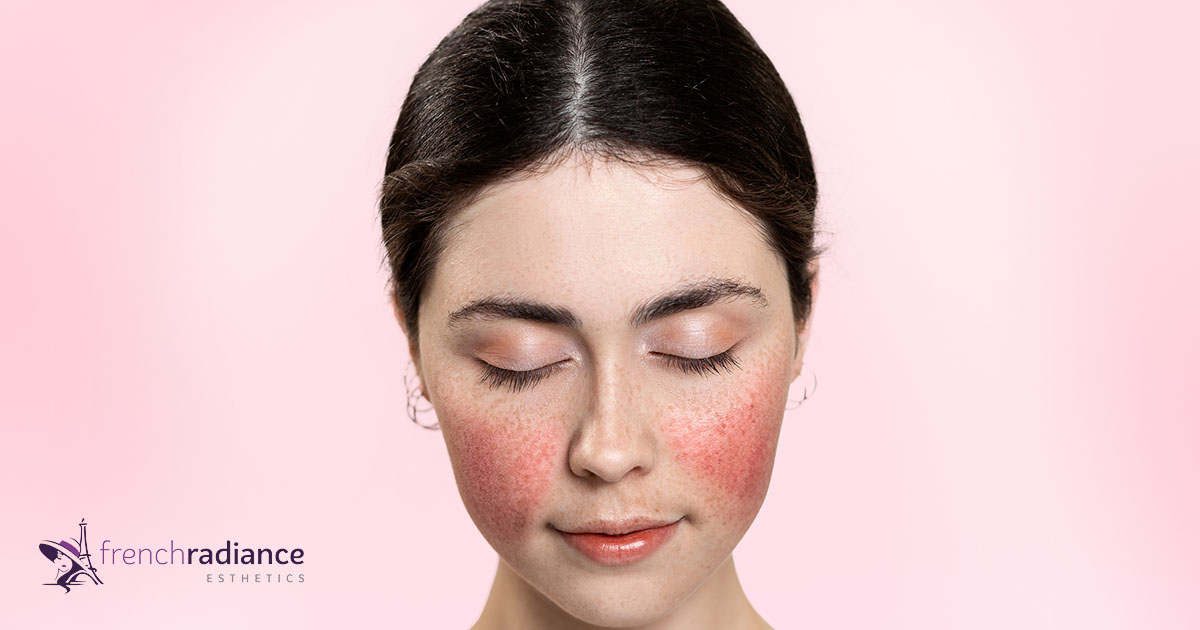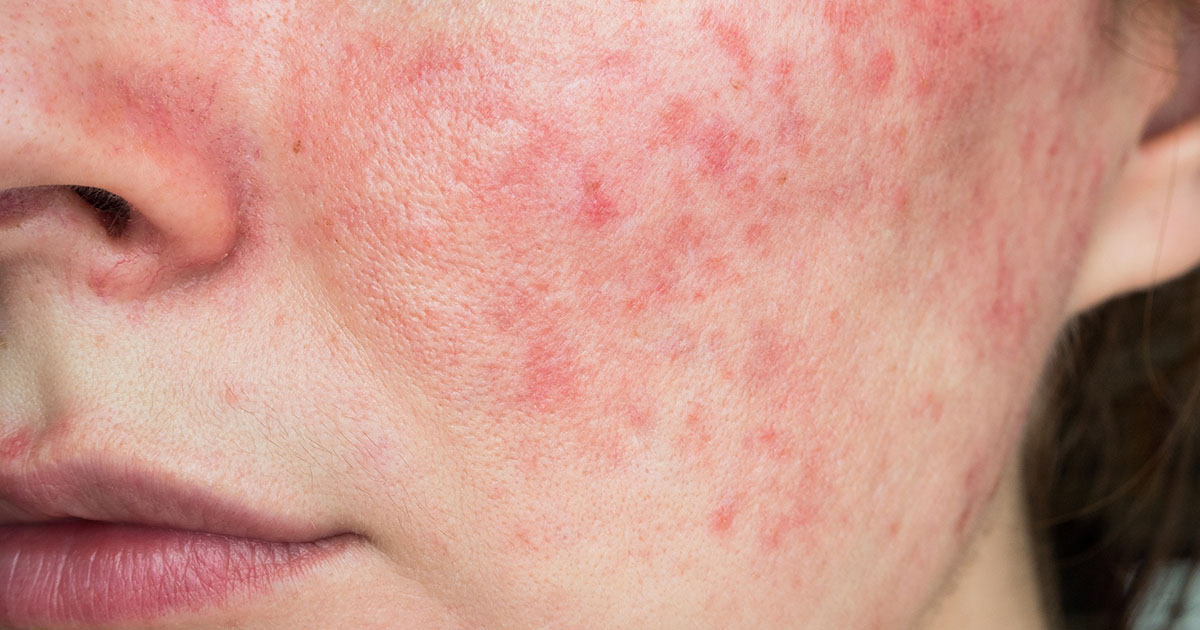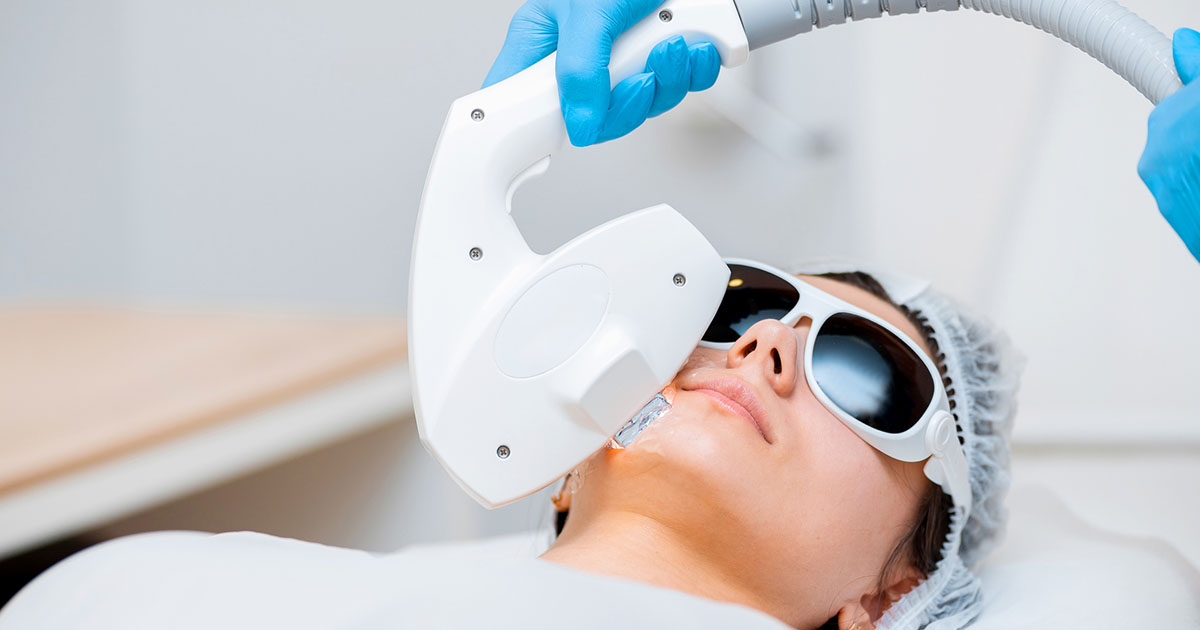
You may wake one day to find a blush has spread, not only across your face, but also over your chest, back, and ears. Slowly, the red discoloration may turn into broken blood vessels. It may also cause small bumps, filled with pus. The worst comes when your previously annoying rash becomes aggravated and irritates your eyes. If this sounds like your skin, you may have rosacea.
Rosacea affects at least 16 million people in the United States alone, and approximately 5% of all people worldwide. 1 As a result, the first thing you should learn about rosacea is that you are certainly not alone. Now, let’s learn more about rosacea, which is key to caring for your skin.
What Is Rosacea?
Rosacea is a skin condition that causes redness and the visible appearance of blood vessels in the flushed area. It usually begins as a blush of the skin across the cheeks, nose, chin, and forehead. Without treatment, the redness in the center of the face may become prominent. Eventually, it is possible that the chest, back, and ears will appear flushed in the same manner as the face.
The condition is more prevalent in women. However, men with rosacea may see more severe symptoms. Rosacea is a chronic condition with no known cure yet. Because there are many symptoms and signs of rosacea, there are four subtypes of the condition.
1. Erythematotelangiectatic Rosacea
This subtype of rosacea is characterized by frequent episodes of flushing of the skin, general redness, and visible blood vessels. It may also be accompanied by facial swelling, stinging, or burning. 2 This type of rosacea responds poorly to treatment.
2. Ocular Rosacea
Ocular rosacea is characterized by swollen eyelids, irritated or red eyes, and cysts that may form on the eyelid. It may include itching or burning of the eyes, dryness, light sensitivity, blood vessels that are dilated in the whites of the eyes, recurring eyelid or eye infections, and/or blurred vision.
3. Papulopustular Rosacea
Those with this subtype of rosacea often see pus-filled blemishes on the skin, as well as red bumps. These are typically misidentified as acne, and emerge on the chin, cheeks, and forehead. These blemishes may also appear on the chest, neck, or scalp. Papulopustular rosacea may also be accompanied by flushing and facial redness.
4. Phymatous Rosacea
This is potentially the most severe subtype of rosacea. Symptoms include hardening of the skin, scarring, swelling, bumpiness, and discoloration. This is the rarest subtype of rosacea and may also include what is referred to as a bulbous nose, or rhinophyma. It more commonly affects men.
What Are the Common Symptoms of Rosacea?
 Rosacea causes a variety of symptoms common in other skin conditions and is commonly misdiagnosed. In addition, symptoms among the different varieties of rosacea can appear at the same time, which may mean a person has more than one type of rosacea.
Rosacea causes a variety of symptoms common in other skin conditions and is commonly misdiagnosed. In addition, symptoms among the different varieties of rosacea can appear at the same time, which may mean a person has more than one type of rosacea.
Some of the most common symptoms include:
Flushing or Facial Blushing
Recurring blushing of the central part of the face is the most common symptom associated with rosacea. This can be difficult to recognize in those with deeper skin tones.
Dryness or Roughness
Facial skin may become dry or rough, and scaling may become present, as well as oiliness.
Swollen Bumps
Over time, those with rosacea may develop bumps on the face. They can be pus-filled or appear simply as red, swollen bumps. These bumps are commonly misdiagnosed as acne instead of being attributed to rosacea.
Visible Veins
Across the nose and cheeks, small blood vessels may break and come to be visible across the face. This symptom is also referred to as spider veins.
Burning Feeling
Across the areas of the face that are flushed, a person may experience the face feeling warm and/or tender.
Enlarged Nose
Thickening across the skin may cause a swelling of the nose. The hardening of bumps makes the nose appear bulbous, called rhinophyma. This is a symptom that occurs more frequently in men than women.
Thickening Skin
While the nose may appear bulbous, other parts of the facial skin may also thicken. The chin, cheeks, forehead, and ears may all experience thickening skin.
Vision and Eye Trouble
Those with rosacea may suffer from dry, irritated eyes, light sensitivity, swelling of the eyes and eyelids, and blurry vision.
These symptoms can also spread across the chest and the back, as well as the scalp. Many of these symptoms overlap with other kinds of conditions including acne, eczema, seborrheic dermatitis, lupus, and psoriasis.
What Causes Rosacea?
Rosacea is a fairly common condition across the United States. While it has been difficult to pinpoint the causes of rosacea, doctors and scientists have discovered several important pieces of evidence:
Immune System Links
Rosacea may be linked to the immune system. 3 Many experiencing acne-like rosacea have been found to have an immune system reaction to the bacteria bacillus oleronius, which is present on the skin. During the earlier stages of rosacea, the immune system appears to affect rosacea pathophysiology.
Heredity
Rosacea appears to be hereditary. Many of those with rosacea have family members who also have rosacea, and it is more common in certain ethnic groups. Thus, it appears that rosacea may be linked to genetics.
Skin Mites
A skin mite may play a role. 4 This mite, known as a demodex, lives on the skin, most commonly on the cheeks and nose. Findings have shown people with rosacea have higher numbers of these mites. However, those without rosacea can have higher numbers of these mites, too, and research is ongoing.
Protein
A protein may be linked to rosacea. The protein cathelicidin typically guards the skin against infection. The ways the body handles this protein may influence whether someone develops rosacea.
Bacterial Infection
Helicobacter pylori (H. pylori), a bacterium triggering skin and other infections, might play a role in rosacea. H pylori is frequently found in those with rosacea. However, not everyone with an H. pylori infection has rosacea.
While the above circumstances may affect the condition, not enough is known to pinpoint the direct cause of rosacea.
Who Gets Rosacea?
When any kind of chronic skin condition is being discussed, it’s always important to know the risk factors involved. Rosacea is no different. While it’s not yet known exactly what causes rosacea, there are several risk factors that have been linked to rosacea.
Some of these include:
Being a Woman
Women are more likely to have rosacea than men, although men tend to have more severe symptoms.
Being Between the Ages of 30 to 60
This age bracket is more susceptible to rosacea than others outside it.
Having Fair or Light Skin
Those with fair skin, light or blonde hair, and blue eyes are more prone to having rosacea. 5
Blushing Easily
As rosacea is an extreme flushing of the face, those who blush easily appear to be at a higher risk of rosacea.
Having a Family Member With Rosacea
Rosacea does appear to have some genetic connection.
Having Scandinavian or Celtic Ancestry
People of these northern European heritages are more prone to rosacea than others.
It’s important to note that rosacea is not caused by poor hygiene, and it is also not contagious.
How Is Rosacea Diagnosed?
A medical test isn’t required to determine whether a person has rosacea or not. However, a dermatologist will examine skin and eyes, and ask some questions before delivering a diagnosis. Because a few different conditions present similarly to rosacea, a dermatologist will want to rule those conditions out before diagnosing rosacea.
In those with deeper skin tones, rosacea is often missed or inaccurately diagnosed as seborrheic dermatitis or an allergic reaction. In this and other cases, the most obvious symptom that will separate rosacea from other conditions is the incidence of visible, enlarged blood vessels. An early diagnosis of rosacea is ideal so you can prevent it from worsening with medications and develop a skincare regimen to control flare-ups.
How Is Rosacea Treated?
As rosacea is a chronic condition, there is no cure. However, there are some treatments that help most people successfully manage rosacea. The most typical treatments are a good skincare routine developed by a professional, combined with medication.
In recent years, more medications have been developed to help treat rosacea.
These include:
Oral Antibiotics
A mild antibiotic might be prescribed to manage moderate to severe rosacea with the presence of acne or bumps.
Oral Acne Medication
If other rosacea treatments are ineffective, a doctor may prescribe isotretinoin. This may help severe cases of rosacea with lesions.
Topicals
Your favorite med spa knows what cream is best for rosacea. Topical creams and gels can be prescribed to help reduce flushing and redness by tightening blood vessels, as well as topicals prescribed to treat the bumps and acne symptoms common with rosacea.
Laser Therapy
Laser therapy might make visible blood vessels less obvious but may take several weeks to be noticeable. This treatment isn’t recommended for those with deeper skin tones as permanent damage may be done.
Rosacea FAQs
As a med spa, we frequently answer questions about rosacea. Here are some of the most common:
Q: How Do You Clear Up Rosacea?
A: A series of topicals, medications, and a good skin care routine may help.
Q: What Should You Not Do With Rosacea?
To help avoid a rosacea flareup, consider the following:
- Limiting wind or sun exposure
- Avoiding extreme temperatures
- Not consuming alcoholic beverages, particularly red wine
- Avoiding spicy foods and hot beverages
- Keeping emotions in check
- Not using particular skin, hair, or cosmetic products
- Avoiding very strenuous exercise
- Not using certain drugs that cause blood vessels to dilate
Q: How Common Is Rosacea in Women?
A: A 2018 article suggests 5.41% of women have rosacea, while 3.90% of men have rosacea. 6
Q: Is Rosacea Linked to the Liver?
A: While there is no confirmed direct link, there are suggestions that there is a potential association.
Q: Can Rosacea Be a Symptom of Something Else?
A: Rosacea doesn’t appear to be a symptom of something else but having rosacea may increase the risk for other diseases.
Q: What Should I Wash My Face With if I Have Rosacea?
A: Using a face wash that moisturizes and doesn’t irritate the skin is best. Look for natural, calming products without foaming action.
Q: Does Rosacea Worsen With Age?
A: Rosacea can worsen over time, especially if untreated.
Q: How Can I Reduce Redness on My Face, Fast?
A: Avoiding your triggers, such as spicy foods and alcohol, may help reduce the incidence of a flare up. Topical creams and gels may help as well.
Rosacea Treatment
 Rosacea is much more common than you may think, affecting many throughout America and the world. While there is no cure for rosacea, the good news is that there are treatments available to address flare-ups, whether your condition is mild or severe.
Rosacea is much more common than you may think, affecting many throughout America and the world. While there is no cure for rosacea, the good news is that there are treatments available to address flare-ups, whether your condition is mild or severe.
Here at French Radiance we use Cosmetic Laser Treatments to help treat Rosacea. Contact us to learn more.
Sources:
- Buddenkotte, J., & Steinhoff, M. (2018). Recent advances in understanding and managing rosacea. F1000Research, 7, F1000 Faculty Rev-1885. https://doi.org/10.12688/f1000research.16537.1
- Shanler SD, Ondo A (2007. Successful Treatment of the Erythema and Flushing of Rosacea Using a Topically Applied Selective α1-Adrenergic Receptor Agonist, Oxymetazoline. Arch Dermatol. 2007;143(11):1369–1371. https://doi.org/10.1001/archderm.143.11.1369
- Steinhoff, M., Schauber, J., & Leyden, J. J. (2013, December). New insights into rosacea pathophysiology: A review of recent findings. Journal of the American Academy of Dermatology, 69(6), S15-S26. https://doi.org/10.1016/j.jaad.2013.04.045
- van Zuuren, E.J., Arents, B.W.M., van der Linden, M.M.D. et al. Rosacea: New Concepts in Classification and Treatment. Am J Clin Dermatol 22, 457–465 (2021). https://doi.org/10.1007/s40257-021-00595-7
- Mikkelsen, C. S., Holmgren, H. R., Kjellman, P., Heidenheim, M., Kappinnen, A., Bjerring, P., & Huldt-Nystrøm, T. (2016). Rosacea: a Clinical Review. Dermatology reports, 8(1), 6387. https://doi.org/10.4081/dr.2016.6387
- Gether, L., Overgaard, L. K., Egeberg, A., & Thyssen, J. P. (2018). Incidence and prevalence of rosacea: a systematic review and meta‐analysis. British Journal of Dermatology, 179(2), 282-289. https://doi.org/10.1111/bjd.16481